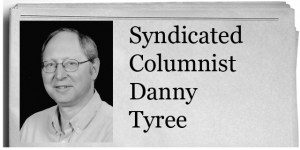Roger Gates: Learning the value of hay
Published 8:48 pm Tuesday, October 24, 2017

- Werner and Mary Braun: Call me a skeptic ... maybe
The Sunbelt Ag Expo is held every October in Moultrie. The 2017 edition ran Oct. 16-18. The October Expo follows a Field Day held annually in July.
More than 600 acres of land at the Expo site is dedicated to research conducted by University of Georgia researchers and agricultural industry partners. Presentations during the Field Day allow farmers to learn the latest information related to crop and forage production. Trials at the site demonstrate the response of the latest crop varieties, crop protection products and related management techniques. Important crops investigated include cotton, peanuts, corn, soybeans, bermudagrass and alfalfa. During the October Expo, farmers can see and even operate the latest in farm equipment including tillage, planting and harvesting devices.
Trending
For the last 13 years the Extension Services in Georgia, Florida, Alabama and South Carolina have organized the Southeastern Hay Contest. The contest is an opportunity to recognize the efforts of producers that work to manage their forage crops in order to harvest a superior product. Forages are an important farm product, but because they are used almost entirely for livestock feed may not receive the same attention as grain and fiber commodities.
Manufactured feeds are legally required to test and report the nutrient content contained in the product, much like food product nutritional labels that grocery shoppers are familiar with. Grain commodities do not have the same requirement, but current varieties and production practices generally result in products with very consistent nutrient content.
Nutritional content of hay is much less consistent and, in spite of its importance and sizable contribution to livestock diets, is often fed without good information about its value. Hay crops are most often perennial — the producer expects to be able to harvest the crop for a number of years without replanting. Modern forage varieties are well adapted to regrow after being cut, so farmers may harvest several times in a single growing season. Many different species, primarily grasses and forage legumes, are used for hay production, often in mixtures.
Hay nutritional value is strongly influenced by the maturity of the crop when it is cut, how long the plant has grown since the start of the growing season or since it was last cut. A final variable affecting hay value is the weather conditions during harvest. Hay must be dried to contain no more than 15 percent moisture in order to be stored safely. At higher moisture, hay may mold and even ignite and burn.
Characteristics such as color, texture and odor can provide limited indications about how well a particular lot of hay will support livestock nutrition, but the only certain information requires a hay test. Modern laboratory procedures can estimate the nutritional content of hay samples rapidly and accurately. A hay test for each entry in the Southeastern Hay Contest is the primary judging criteria used to rank the entries.
This year, 328 entries were submitted to the Southeastern Hay Contest. Entries were judged in seven categories: warm-season perennial grass hay (bermudagrass, bahiagrass), alfalfa hay, perennial peanut hay, cool-season perennial grass hay (tall fescue, orchardgrass), mixed annual or other grass hay, grass baleage and legume baleage. In each of the categories, the highest three entries in terms of relative forage quality (RFQ) received cash prizes. First-place winners received $125, second-place winners received $75 and third-place winners received $50. Forage producers from Georgia went home with 13 of the available placings. Oak Ridge Ranch in Dahlonega won in the cool-season perennial grass hay category, and Jeff Bacon of Dudley won the warm-season perennial grass hay category.
Trending
The overall winner, who produced alfalfa hay with an RFQ of 269, was Seldom Rest Farm of Pulaski, Tenn. The grand prize was a choice of either a Massey Ferguson DM series disc mower or an RK Series rotary rake for use during the 2018 hay production season plus $1,000.
A winning entry at the contest can enhance the reputation of a farmer who produces hay commercially, but any livestock producer who feeds hay can use hay test results to their advantage. Because hay may not meet all the nutritional needs of a class of livestock, supplemental feeds are often purchased and fed in order to “balance the ration.” Without knowing the content of the hay being fed, supplements may be fed in excess, representing unnecessary expense or, if supplements are not sufficient, a nutrient deficiency may limit animal performance, costing the producer when it comes time to sell.
Roger Gates is the agricultural and natural resources agent for University of Georgia Extension, Whitfield County. Contact him at roger.gates@uga.edu.




